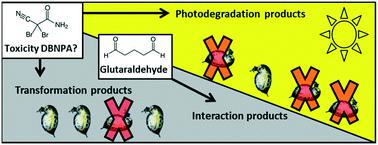当前位置:
X-MOL 学术
›
Environ. Sci.: Water Res. Technol.
›
论文详情
Our official English website, www.x-mol.net, welcomes your
feedback! (Note: you will need to create a separate account there.)
Impact of transformation, photodegradation and interaction with glutaraldehyde on the acute toxicity of the biocide DBNPA in cooling tower water
Environmental Science: Water Research & Technology ( IF 3.5 ) Pub Date : 2020-02-06 , DOI: 10.1039/c9ew01018a Thomas V. Wagner 1, 2, 3, 4, 5 , Rick Helmus 1, 2, 3, 4 , Elmar Becker 1, 2, 3, 4 , Huub H. M. Rijnaarts 4, 5, 6, 7 , Pim de Voogt 1, 2, 3, 4, 5 , Alette A. M. Langenhoff 4, 5, 6, 7 , John R. Parsons 1, 2, 3, 4
Environmental Science: Water Research & Technology ( IF 3.5 ) Pub Date : 2020-02-06 , DOI: 10.1039/c9ew01018a Thomas V. Wagner 1, 2, 3, 4, 5 , Rick Helmus 1, 2, 3, 4 , Elmar Becker 1, 2, 3, 4 , Huub H. M. Rijnaarts 4, 5, 6, 7 , Pim de Voogt 1, 2, 3, 4, 5 , Alette A. M. Langenhoff 4, 5, 6, 7 , John R. Parsons 1, 2, 3, 4
Affiliation

|
The reuse of cooling tower water (CTW) can substantially lower the freshwater footprint of cooling towers. CTW requires desalination before its reuse, and pre-treatment before desalination enhances the desalination efficiency. Constructed wetlands (CWs) have been shown to remove fractions from CTW that hamper physico-chemical desalination technologies, and thus provide adequate pre-treatment. However, CTW contains biocides, and these and their transformation products are potentially toxic to aquatic fauna in surface flow CWs. Therefore, we assessed the acute toxicity to daphnids of CTW which contained the biocide 2,2-dibromo-3-nitrilopropionamide (DBNPA), and the impact of photodegradation and the presence of biocide glutaraldehyde on its toxicity. It was observed that the toxicity of DBNPA in CTW was lower than that reported in the literature, and non-target screening showed that this was due to rapid DBNPA transformation, via 2-monobromo-3-nitrilopropionamide (MBNPA) and nitrilopropionamide (NPA). Photodegradation resulted in an increased CTW toxicity after 1 h of illumination as a result of the formation of new DBNPA transformation products, and subsequent decrease in toxicity after 48 h. The simultaneous presence of DBNPA and glutaraldehyde resulted in the formation of interaction products. Photodegradation did not result in unique interaction products, but increased the rate of interaction product formation, leading to a decrease in toxicity. Due to the toxicity of DBNPA in CTW and the effect of photodegradation on this toxicity, it is not recommended to use a surface flow CW as first treatment step in a multistage CW-system for the treatment of CTW.
中文翻译:

转化,光降解和与戊二醛的相互作用对冷却塔水中杀菌剂DBNPA急性毒性的影响
冷却塔水(CTW)的再利用可以大大降低冷却塔的淡水足迹。CTW在重新使用之前需要进行脱盐处理,而在脱盐之前进行预处理可以提高脱盐效率。人工湿地(CW)已被证明可以去除CTW中妨碍物理化学脱盐技术的馏分,从而提供适当的预处理。但是,CTW含有杀生物剂,这些杀虫剂及其转化产物可能对地表CW中的水生动物有毒。因此,我们评估了含有杀生物剂2,2-二溴-3-硝基丙酰胺(DBNPA)的CTW对水蚤的急性毒性,以及光降解和杀生物剂戊二醛的存在对其毒性的影响。据观察,DBNPA在CTW中的毒性低于文献报道,通过2-一溴-3-硝酰丙酰胺(MBNPA)和次氮丙酰胺(NPA)。由于新的DBNPA转化产物的形成,光降解导致光照1 h后CTW毒性增加,而48 h后毒性降低。DBNPA和戊二醛的同时存在导致相互作用产物的形成。光降解不会产生独特的相互作用产物,但是会增加相互作用产物的形成速率,从而导致毒性降低。由于DBNPA在CTW中的毒性以及光降解对该毒性的影响,因此不建议在多级CW系统中将表面流CW作为第一步处理步骤来处理CTW。
更新日期:2020-02-06
中文翻译:

转化,光降解和与戊二醛的相互作用对冷却塔水中杀菌剂DBNPA急性毒性的影响
冷却塔水(CTW)的再利用可以大大降低冷却塔的淡水足迹。CTW在重新使用之前需要进行脱盐处理,而在脱盐之前进行预处理可以提高脱盐效率。人工湿地(CW)已被证明可以去除CTW中妨碍物理化学脱盐技术的馏分,从而提供适当的预处理。但是,CTW含有杀生物剂,这些杀虫剂及其转化产物可能对地表CW中的水生动物有毒。因此,我们评估了含有杀生物剂2,2-二溴-3-硝基丙酰胺(DBNPA)的CTW对水蚤的急性毒性,以及光降解和杀生物剂戊二醛的存在对其毒性的影响。据观察,DBNPA在CTW中的毒性低于文献报道,通过2-一溴-3-硝酰丙酰胺(MBNPA)和次氮丙酰胺(NPA)。由于新的DBNPA转化产物的形成,光降解导致光照1 h后CTW毒性增加,而48 h后毒性降低。DBNPA和戊二醛的同时存在导致相互作用产物的形成。光降解不会产生独特的相互作用产物,但是会增加相互作用产物的形成速率,从而导致毒性降低。由于DBNPA在CTW中的毒性以及光降解对该毒性的影响,因此不建议在多级CW系统中将表面流CW作为第一步处理步骤来处理CTW。











































 京公网安备 11010802027423号
京公网安备 11010802027423号